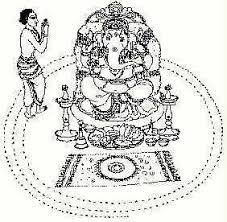Pradakshina, also known as Parikrama, is an ancient spiritual practice in Hinduism where devotees walk in a circular path around a sacred object, deity, or temple. This act of circumambulation is more than just a ritual—it is a symbolic gesture that expresses reverence for the divine, acknowledging that the divine presence is the center of all existence. While it may appear simple, Pradakshina holds deep spiritual meaning and offers profound benefits for the soul.

At its heart, Pradakshina is a practice of connecting with the divine and recognizing the cyclical nature of life. Through the circular motion, devotees acknowledge the cosmic truth that everything in the universe moves around the divine source.
The Deeper Meaning of "Pradakshina"

The term "Pradakshina" itself offers a wealth of spiritual wisdom. It is composed of four key syllables that carry significant meaning:
- Pra: The removal of ignorance.
- Da: The fulfillment of all desires.
- Kshi: Freedom from the cycle of birth and death.
- Na: Deliverance through gnana (knowledge or wisdom).
This breakdown of "Pradakshina" reveals that it is not just a physical act but a deeply spiritual process. As one walks the path of circumambulation, they are symbolically removing ignorance and aligning with divine knowledge, leading to the fulfillment of desires and ultimately liberation from the cycle of life and death. This deliverance is done through gnana—the realization of higher truths and the understanding of the self as one with the divine.
Spiritual Significance of Parikrama
Pradakshina, or Parikrama, is not just an external movement; it is a journey inward. As devotees circle the deity or sacred space, they are reminded of the divine as the ultimate center around which all existence revolves. This act signifies the realization that everything, including our individual lives, is part of a greater cosmic cycle.
Performing Pradakshina also symbolizes surrender. It is a recognition that, while we are active participants in life, the divine power is the true guide and protector. By keeping the deity on our right side during the circumambulation, we acknowledge the divine as our constant guide, ensuring that we live in alignment with spiritual principles.
Pradakshina and Life's Ultimate Goals
The four meanings behind the word "Pradakshina" can also be seen as representing the stages of spiritual evolution:
- Removal of Ignorance (Pra): In Hindu philosophy, ignorance (avidya) is seen as the root cause of suffering. By performing Pradakshina with awareness, devotees seek to clear the fog of ignorance and align themselves with the truth of their divine nature.
- Fulfillment of Desires (Da): While desires are often viewed as distractions on the spiritual path, the deeper understanding is that when we align with the divine, our desires become purified. They are no longer rooted in ego or materialism but in the desire for spiritual growth and the well-being of all beings.
- Freedom from the Cycle of Birth and Death (Kshi): The ultimate goal of Pradakshina is to break free from the continuous cycle of reincarnation. As devotees perform this sacred act, they move closer to realizing their true nature beyond the physical realm, aiming for liberation (moksha).
- Deliverance through Knowledge (Na): True deliverance comes through gnana—the knowledge that we are not separate from the divine. Pradakshina encourages this realization, guiding us toward understanding that the self and the divine are one.
The Ritual and Its Varied Forms
Pradakshina is performed in various ways, depending on the context and the type of temple or sacred site. Common forms include:
- Temple Pradakshina: Devotees walk around the sanctum sanctorum of the temple, keeping the deity at the center. This is the most widespread form, performed at temples dedicated to various deities like Shiva, Vishnu, or Devi.
- Mountain Parikrama: Devotees circumambulate sacred mountains such as Arunachala Hill, believed to be a manifestation of Lord Shiva. This type of Parikrama represents the journey around natural forms that embody divine energy.
- River Parikrama: In this form, devotees walk along the banks of sacred rivers like the Ganges, symbolizing purification and the flow of divine grace.
The Benefits of Performing Pradakshina
- Spiritual Growth: By engaging in Pradakshina, devotees experience a deeper connection to their spiritual essence. Each step is an opportunity to reflect on the divine presence in their lives and remove the layers of ignorance that block true wisdom.
- Energetic Alignment: The act of walking in a circular motion around sacred spaces is believed to cleanse one's energy field, bringing harmony and peace to the mind, body, and spirit.
- Fulfillment of Higher Desires: While Pradakshina is not performed with the aim of material gain, it is said that those who perform it with pure devotion often experience a natural fulfillment of their higher desires. These may include desires for spiritual growth, peace, or the well-being of loved ones.
- Liberation and Inner Freedom: Pradakshina represents a microcosm of the soul's journey through life. By performing this sacred act, devotees move closer to liberation, freeing themselves from the illusions of the material world and realizing their true nature.
Conclusion
Pradakshina Parikrama is a powerful spiritual practice that encompasses the deeper teachings of Hindu philosophy. Each step around the sacred deity or temple is a reminder that the divine is the center of all existence. As we circumambulate, we symbolically remove ignorance, fulfill our higher desires, and move closer to freedom from the cycle of birth and death, guided by divine knowledge.
Incorporating the principle of "PRa" (removal of ignorance), "Da" (fulfillment of desires), "Kshi" (freedom from reincarnation), and "Na" (deliverance through wisdom), Pradakshina becomes a transformative experience—one that allows us to align our lives with the divine purpose and walk the path toward spiritual liberation


0 Comments